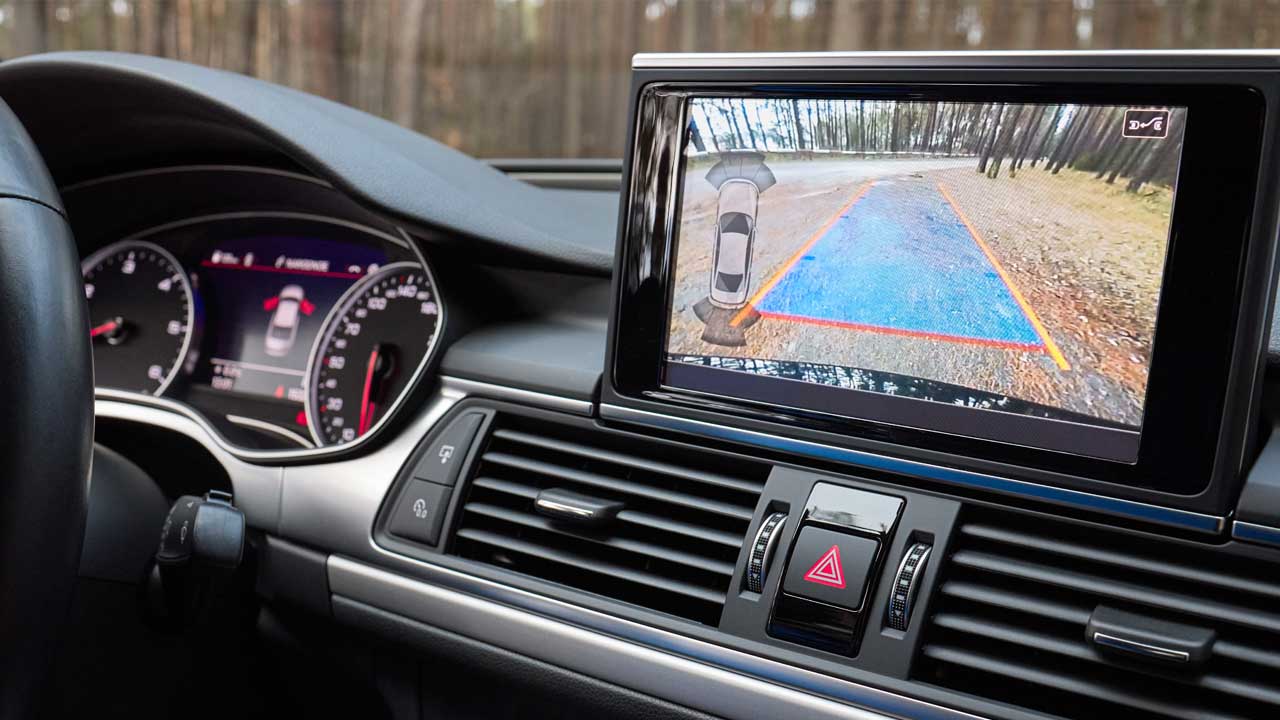SLVAF69 August 2021 TPS1HC100-Q1
1 Application Brief
The push for smart peripherals and autonomous driving is ever present with increasing electrification in the automotive industry. With that, the complexity and robustness of the advanced driver assistance systems (ADAS) have also greatly increased. One of the key focus areas in ADAS is front camera modules. Camera modules, specifically the front cameras, are crucial to the system as they take in video data and interpret information such as stop signs, people, and other cars. However, accurate turn on and turn off control of these modules increases overall system efficiency including monitoring and mitigating different faults such as short to battery, open load. Powering of these front camera modules is typically done using a smart high side switch similar to TPS1HC100-Q1.
Camera Modules
 Figure 1-1 Camera Application
Figure 1-1 Camera ApplicationCamera modules are typically electronic control units (ECU) that are powered from the car battery or another control module with on board DC/DC's. These modules have microcontrollers for the digital processing along with a defogger (heater) for when the camera gets fogged up and diagnostics and or monitoring to make sure the signal coming in is correct. Typically it is a smart high side switch that delivers power to camera modules from other upstream power distribution blocks and or modules. Additionally, on these camera modules, a smart high side switch would be used to power on and off the defogger. Both of these loads (the full module and the defogger) have distinct challenges associated with driving them.
Driving Front Camera Modules (Capacitive Loads)
The full camera module has DC/DC's and or LDO's powering other circuitry on the board. These DC/DC's and LDO's have a typical current draw of ≤2A but have large input capacitors which can result in high inrush current spikes when turning on the module. These capacitance's are in the 100's μF range that, if not regulated, would pull >30A until the voltage on the capacitor was charged up.
TPS1HC100-Q1 Driving Front Camera Modules
TI's TPS1HC100-Q1 is a single-channel smart high-side switch with adjustable current limiting that can enable robust protection of the front camera module. The current limit is set externally by a resistor (or internally by leaving the pin floating or shorted to ground) and follows the KCL ratio to determine the value that it will regulate the output current. Additionally, adding a resistor in parallel through a switch can turn the static current limit, into a dynamic one.
TPS1HC100-Q1
When the system turns the TPS1HC100-Q1 on, the SW switch in the picture above is closed causing the effective resistance at the ILIM pin to be reduced thereby making the current limit higher. Then, after the output is charged up, the SW can be disabled causing the effective resistance at the ILIM pin to increase and setting the current limit threshold to a lower value that is near the nominal load current. This timing is shown in Figure 1-5.
For additional general information about driving capacitive loads with smart high side switches, please see https://www.ti.com/lit/pdf/SLVAE30 application report.
Driving Defoggers (Resistive Loads)
Defoggers in the camera module can be thought of as heaters or resistive loads. These heaters are turned on to remove the condensation on the cameras so they can have a more clear image. The key careabouts when driving heaters is to have great short circuit protection and accurate current sensing. The short circuit protection protects the system as a whole, including the cables, from seeing high currents during the short circuit event. The current sensing is necessary because the current through the heater load is directly proportional to the heat. This current must be accurately monitored by the system if the temperature is required. Additionally, diagnostics must be done on the sense line that goes into the ADC of the microcontroller on the camera module.
TPS1HC100-Q1 Driving Camera Defoggers
Similar to the capacitive inrush current clamping, the excellent current limiting feature of TPS1HC100-Q1 will once again protect the system during a short circuit event. The output current will be limited to the value set by the current limiting resistor. Additionally, the TPS1HC100-Q1 has accurate current sensing that can reliably sense down to 5mA which is enough to determine if there is an open load condition and only gets more accurate as the load current increases. However, a unique benefit of the TPS1HC100-Q1 is the ability to make sure that when there is a fault (overcurrent, thermal shutdown, open load, and so on), the maximum output voltage on the SNS pin is acceptable for the ADC into which it is going. This is possible by the fault voltage scaling done in the device that makes sure the voltage coming in from the microcontroller on DIAG_EN is the maximum voltage that the SNS pin can put out during a fault.
The range for the current sense is set by the sense resistor chosen. Figure 1-8 is the range with user-defined head room between a fault signal and the proportional current sense output.
For a more in-depth look at this feature and all of the features of the TPS1HC100-Q1, check out the TPS1HC100-Q1 data sheet.